Effects of the Preparation Conditions and Reinforcement Mechanism of Polyvinyl Acetate Soil Stabilizer
Abstract
:1. Introduction
2. Materials and Methods
2.1. Polyvinyl Acetate
- Step 1: According to the recipe provided above, polyvinyl alcohol was dissolved completely after approximately 3.5 h in distilled water under heating, the temperature being 90 °C. Then, the temperature of the mixture was reduced to 70 °C. Subsequently, ammonium persulfate and vinyl acetate were added to the previous emulsion and continuously stirred for about 20 min.
- Step 2: The methyl methacrylate, vinyl versatate, and butyl acrylate (all supplied by Suzhou Bo Chang Chemical Co., Ltd., Suzhou, China) were mixed evenly and then dripped into the reaction system within 2–3 h. Subsequently, the reaction system was kept at 60–73 °C for 30–60 min.
- Step 3: After the reaction system was cooled down to 50–55 °C, the ammonia, plasticizer, dispersant, and buffer were added to the reaction system and stirred evenly. Then, the reaction system was cooled down to room temperature and the final PVAc emulsion was obtained.
2.2. Viscosity Tests
2.2.1. Temperature Test
2.2.2. Initiator Test
2.2.3. Monomer Test
2.2.4. pH Value Test
2.2.5. Dilution Test
2.3. Soil Reinforcement Tests
2.3.1. Vegetation Growth Test
2.3.2. Strength Test
2.3.3. Moisture Retention Test
3. Results
3.1. Results of Viscosity Tests
3.2. Results of Soil Reinforcement Tests
3.2.1. Vegetation Growth Test
3.2.2. Strength Test
3.2.3. Moisture Retention Test
4. Discussion
4.1. Vegetation Growth Characteristic
4.2. Strength Characteristic
4.3. Moisture Retention Characteristic
4.4. Application of Polyvinyl Acetate
5. Conclusions
- Through a series of laboratory tests, it was shown that Tr, CVA, and CAPS obviously affected the viscosity change of the PVAc emulsion under the reaction conditions. With the increase in Tr, CVA, and CAPS, the emulsion viscosity showed an increasing trend initially and then a decreasing trend, which mainly depended on whether the free radical generated by the initiator reached the optimal amount. When such a condition was reached, the monomer molecule was continuously connected with the free radicals to carry out the chain growth reaction. Meanwhile, the change of pH value and Ddi also affected the viscosity value of PVAc. After a comprehensive series of laboratory tests were performed, a range of viscosity values for PVAc was obtained under different conditions. The Tr, CAPS, CVA, pH value, and Ddi were 40–90 °C, 0.05–3%, 2.5–15%, 1.93–11.87, and 0–420%, respectively. Correspondingly, the range of viscosity values were 8.8–7260 MPa·s, 5–6378 MPa·s, 39.23–+∞ MPa·s, 217–1172 MPa·s, and 12.74–7020 MPa·s.
- It was observed from the strength tests that the compressive strength and cohesion of the modified soil sample underwent an obvious improvement as compared with the reference group. Simultaneously, as the CPVAc persistently increased, the UCS and c both witnessed a correspondingly continuous enhancement. This can be attributed to the effect of the PVAc solution on the soil to form a series of chemical bonds and elastic mucosa between the soil particles. Then, the maximum values of UCS and c were observed as 233.3 kPa and 384.4 kPa, respectively. The corresponding viscosity value reached 3003 MPa·s at that time. However, a change in the internal friction angle of the samples was not distinctly observed.
- It can be inferred from the water retention test that as the concentration of the added PVAc solution increased, the moisture retention property of the soil increased correspondingly. This is mainly due to the formation of a large number of reticulated membrane structures with elasticity and glutinousness when the PVAc solution reacted on the soil. Hence, the pores between the soil particles were sufficiently filled with the moisture. From the test results, it was also shown that the spraying of a 30% PVAc solution reduced the soil evaporativity by approximately 7.45% compared with water.
Author Contributions
Funding
Acknowledgments
Conflicts of Interest
References
- Hejazi, S.M.; Sheikhzadeh, M.; Abtahi, S.M.; Zadhoush, A. Shear Modeling of Fiber Reinforced Soil Composite on the Base of Fiber Pull-out Test. Fibers Polym. 2013, 14, 277–284. [Google Scholar] [CrossRef]
- Liu, J.; Bai, Y.; Song, Z.; Wang, Y.; Chen, Z.; Wang, Q.; Kanungo, D.P.; Qian, W. Effect of Basalt Fiber on the Strength Properties of Polymer Reinforced Sand. Fibers Polym. 2018, 19, 2372–2387. [Google Scholar] [CrossRef]
- Cen, W.-J.; Wang, H.; Sun, Y.-J. Laboratory Investigation of Shear Behavior of High-Density Polyethylene Geomembrane Interfaces. Polymers 2018, 10. [Google Scholar] [CrossRef]
- Liu, J.; Qi, X.; Zhang, D.; Feng, Q.; Wang, Y.; Kanungo, D.P. Study on the Permeability Characteristics of Polyurethane Soil Stabilizer Reinforced Sand. Adv. Mater. Sci. Eng. 2017. [Google Scholar] [CrossRef]
- Latifi, N.; Rashid, A.S.A.; Siddiqua, S.; Abd Majid, M.Z. Strength Measurement and Textural Characteristics of Tropical Residual Soil Stabilised With Liquid Polymer. Measurement 2016, 91, 46–54. [Google Scholar] [CrossRef]
- Hamidi, A.; Hooresfand, M. Effect of Fiber Reinforcement on Triaxial Shear Behavior of Cement Treated Sand. Geotext. Geomembr. 2013, 36, 1–9. [Google Scholar] [CrossRef]
- Eid, H.T. Shear Strength of Geosynthetic Composite Systems for Design of Landfill Liner and Cover Slopes. Geotext. Geomembr. 2011, 29, 335–344. [Google Scholar] [CrossRef]
- Raisinghani, D.V.; Viswanadham, B.V.S. Evaluation of Permeability Characteristics of a Geosynthetic-reinforced Soil through Laboratory Tests. Geotext. Geomembr. 2010, 28, 579–588. [Google Scholar] [CrossRef]
- Shu, S.Z.; Muhunthan, B.; Badger, T.C.; Grandorff, R. Load Testing of Anchors for Wire Mesh and Cable Net Rockfall Slope Protection Systems. Eng. Geol. 2005, 79, 162–176. [Google Scholar] [CrossRef]
- Triplett, E.J.; Fox, P.J. Shear Strength of HDPE Geomembrane/Geosynthetic Clay Liner Interfaces. J. Geotech. Geoenviron. Eng. 2001, 127, 543–552. [Google Scholar] [CrossRef]
- Lekha, K.R. Field Instrumentation and Monitoring of Soil Erosion in Coir Geotextile Stabilised Slopes—A Case Study. Geotext. Geomembr. 2004, 22, 399–413. [Google Scholar] [CrossRef]
- Liu, J.; Shi, B.; Jiang, H.; Huang, H.; Wang, G.; Kamai, T. Research on the Stabilization Treatment of Clay Slope Topsoil by Organic Polymer Soil Stabilizer. Eng. Geol. 2011, 117, 114–120. [Google Scholar] [CrossRef]
- Gao, L.; Ren, K.-Y.; Ren, Z.; Yu, X.-J. Study on the Shear Property of Nano-MgO-modified Soil. Mar. Georesour. Geotechnol. 2018, 36, 465–470. [Google Scholar] [CrossRef]
- Chang, I.; Cho, G.-C. Strengthening of Korean Residual Soil with Beta-1,3/1,6-Glucan Biopolymer. Constr. Build. Mater. 2012, 30, 30–35. [Google Scholar] [CrossRef]
- Al-mashhadani, M.M.; Canpolat, O.; Aygormez, Y.; Uysal, M.; Erdem, S. Mechanical and Microstructural Characterization of Fiber Reinforced Fly Ash Based Geopolymer Composites. Constr. Build. Mater. 2018, 167, 505–513. [Google Scholar] [CrossRef]
- Tosti, L.; van Zomeren, A.; Pels, J.R.; Comans, R.N.J. Technical and Environmental Performance of Lower Carbon Footprint Cement Mortars Containing Biomass Fly Ash as a Secondary Cementitious Material. Resour. Conserv. Recycl. 2018, 134, 25–33. [Google Scholar] [CrossRef]
- Wang, Y.; Zhang, G.; Wang, A. Block Reinforcement Behavior and Mechanism of Soil Slopes. Acta Geotech. 2018, 13, 1155–1170. [Google Scholar] [CrossRef]
- Kumar, J.S.; Sharma, P. Geotechnical Properties of Pond Ash Mixed with Cement Kiln Dust and Polypropylene Fiber. J. Mater. Civ. Eng. 2018, 30. [Google Scholar] [CrossRef]
- Golewski, G.L. Evaluation of Morphology and Size of Cracks of the Interfacial Transition Zone (ITZ) in Concrete Containing Fly Ash (FA). J. Hazard. Mater. 2018, 357, 298–304. [Google Scholar] [CrossRef]
- Kim, J.-H.J.; Park, C.-G.; Lee, S.-W.; Lee, S.-W.; Won, J.-P. Effects of the Geometry of Recycled PET Fiber Reinforcement on Shrinkage Cracking of Cement-based Composites. Compos. Part B-Eng. 2008, 39, 442–450. [Google Scholar] [CrossRef]
- Latifi, N.; Horpibulsuk, S.; Meehan, C.L.; Abd Majid, M.Z.; Tahir, M.M.; Mohamad, E.T. Improvement of Problematic Soils with BiopolymerAn Environmentally Friendly Soil Stabilizer. J. Mater. Civ. Eng. 2017, 29. [Google Scholar] [CrossRef]
- Chang, I.; Im, J.; Prasidhi, A.K.; Cho, G.-C. Effects of Xanthan Gum Biopolymer on Soil Strengthening. Constr. Build. Mater. 2015, 74, 65–72. [Google Scholar] [CrossRef]
- Liu, J.; Bai, Y.; Song, Z.; Lu, Y.; Qian, W.; Kanungo, D.P. Evaluation of Strength Properties of Sand Modified with Organic Polymers. Polymers 2018, 10. [Google Scholar] [CrossRef]
- Mohammed, A.S.; Vipulanandan, C. Compressive and Tensile Behavior of Polymer Treated Sulfate Contaminated CL Soil. Geotech. Geol. Eng. 2014, 32, 71–83. [Google Scholar] [CrossRef]
- Tingle, J.S.; Newman, J.K.; Larson, S.L.; Weiss, C.A.; Rushing, J.F. Stabilization Mechanisms of Nontraditional Additives. Transp. Res. Rec. 2007. [Google Scholar] [CrossRef]
- Latifi, N.; Meehan, C.L.; Abd Majid, M.Z.; Horpibulsuk, S. Strengthening Montmorillonitic and Kaolinitic Clays Using a Calcium-based Non-traditional Additive: A micro-level Study. Appl. Clay Sci. 2016, 132, 182–193. [Google Scholar] [CrossRef]
- Mousavi, F.; Abdi, E.; Rahimi, H. Effect of Polymer Stabilizer on Swelling Potential and CBR of Forest Road Material. Ksce J. Civ. Eng. 2014, 18, 2064–2071. [Google Scholar] [CrossRef]
- Rezaeimalek, S.; Huang, J.; Bin-Shafique, S. Evaluation of Curing Method and Mix Design of a Moisture Activated Polymer for Sand Stabilization. Constr. Build. Mater. 2017, 146, 210–220. [Google Scholar] [CrossRef]
- Naeini, S.A.; Ghorbanalizadeh, M. Effect of Wet and Dry Conditions on Strength of Silty Sand Soils Stabilized with Epoxy Resin Polymer. J. Appl. Sci. 2010, 10, 2839–2846. [Google Scholar] [CrossRef]
- Zandieh, A.R.; Yasrobi, S.S. RETRACTED ARTICLE: Study of Factors Affecting the Compressive Strength of Sandy Soil Stabilized with Polymer. Geotech. Geol. Eng. 2010, 28, 139–145. [Google Scholar] [CrossRef]
- Abbaspour, M.; Aflaki, E.; Nejad, F.M. Reuse of Waste Tire Textile Fibers as Soil Reinforcement. J. Clean. Prod. 2019, 207, 1059–1071. [Google Scholar] [CrossRef]
- Song, Z.; Liu, J.; Bai, Y.; Wei, J.; Li, D.; Wang, Q.; Chen, Z.; Kanungo, D.P.; Qian, W. Laboratory and Field Experiments on the Effect of Vinyl Acetate Polymer-Reinforced Soil. Appl. Sci. 2019, 9. [Google Scholar] [CrossRef]
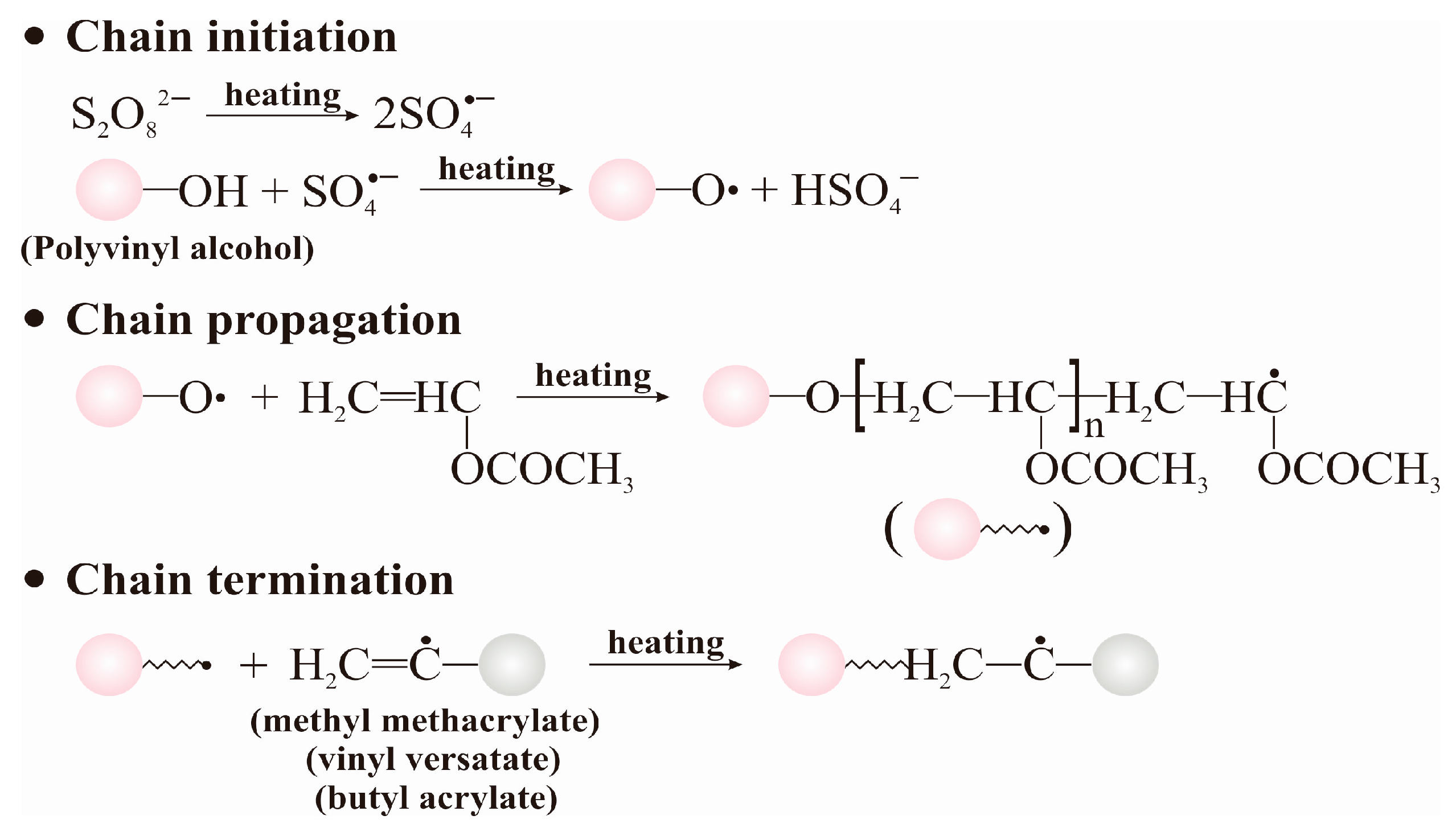
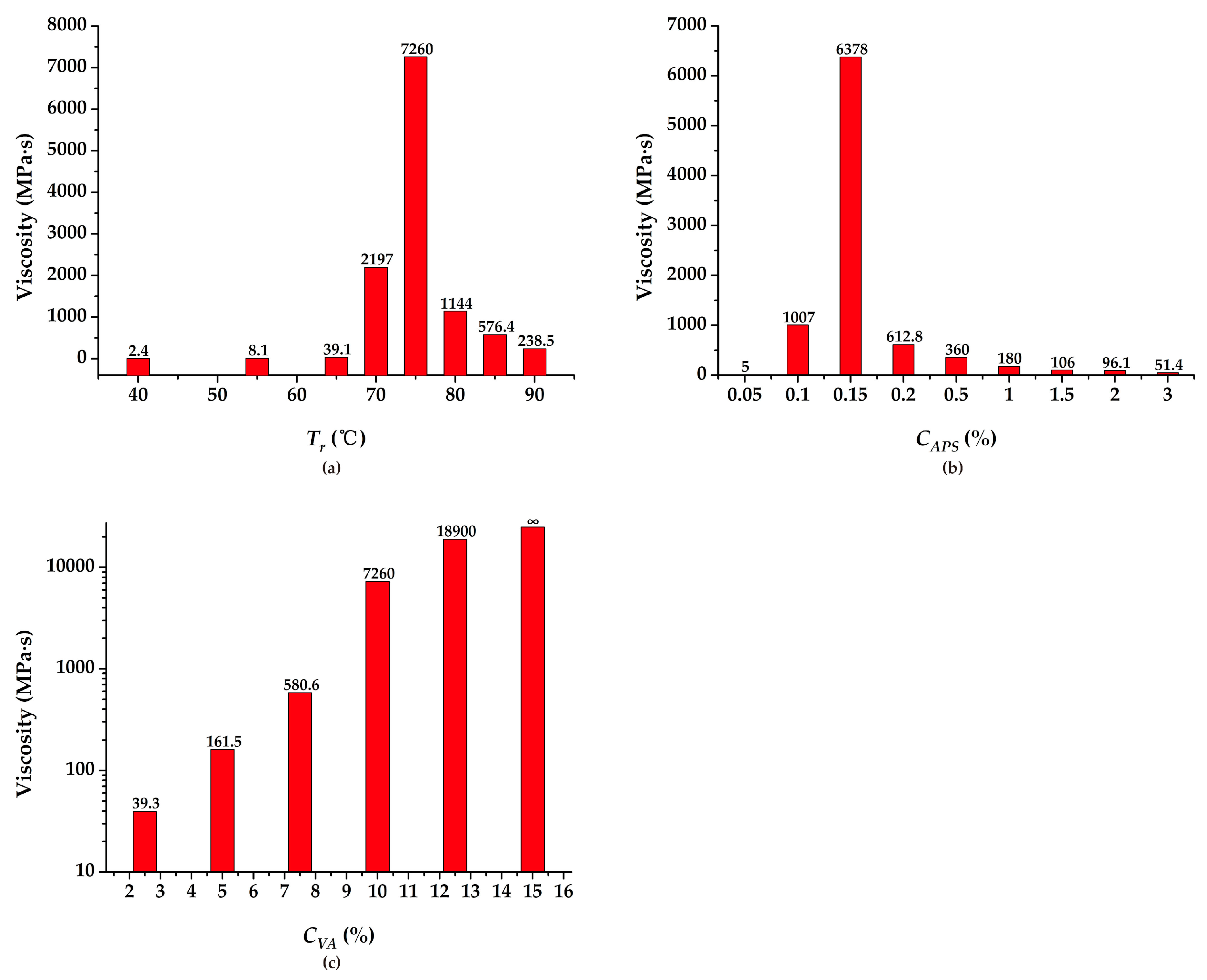
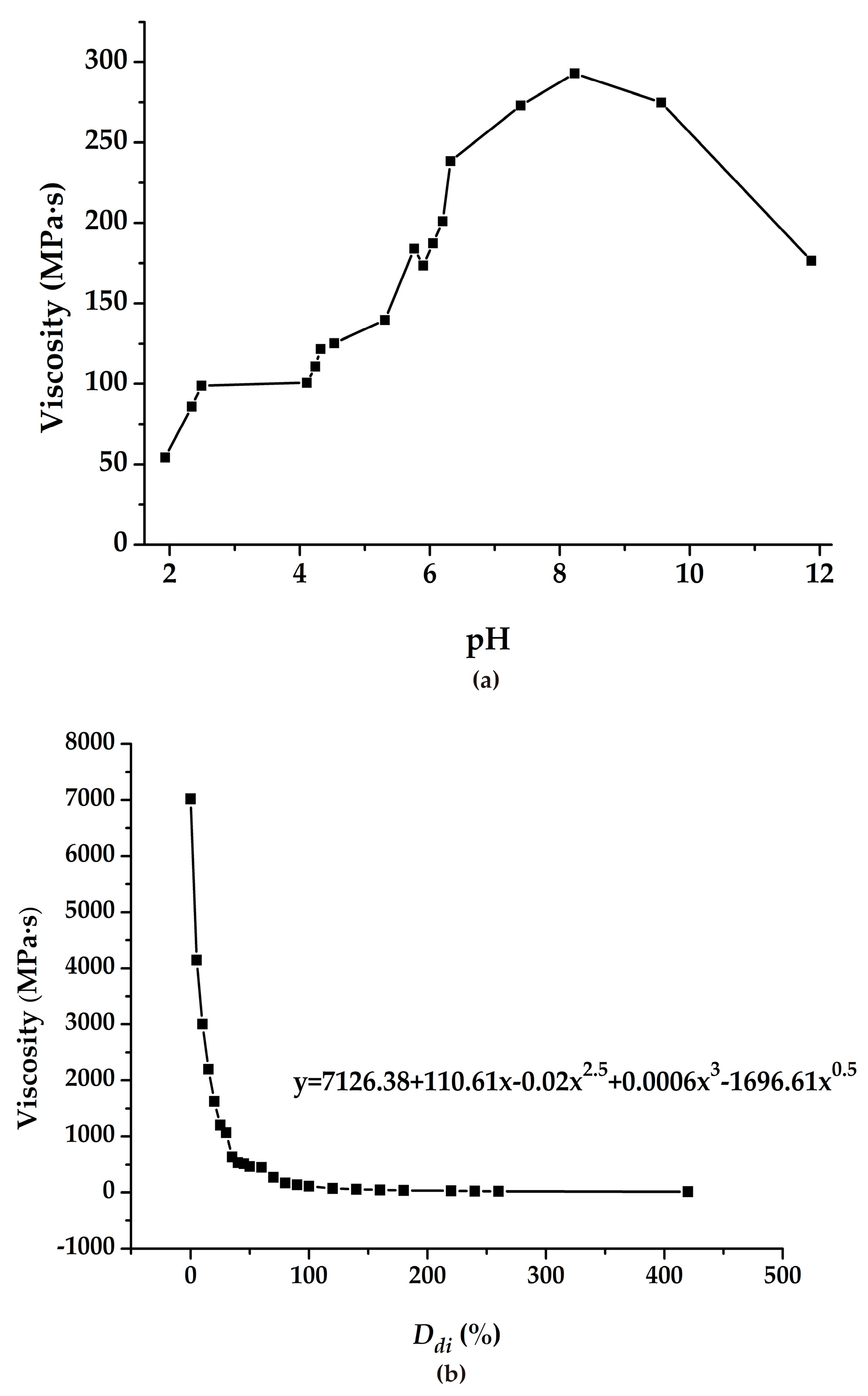
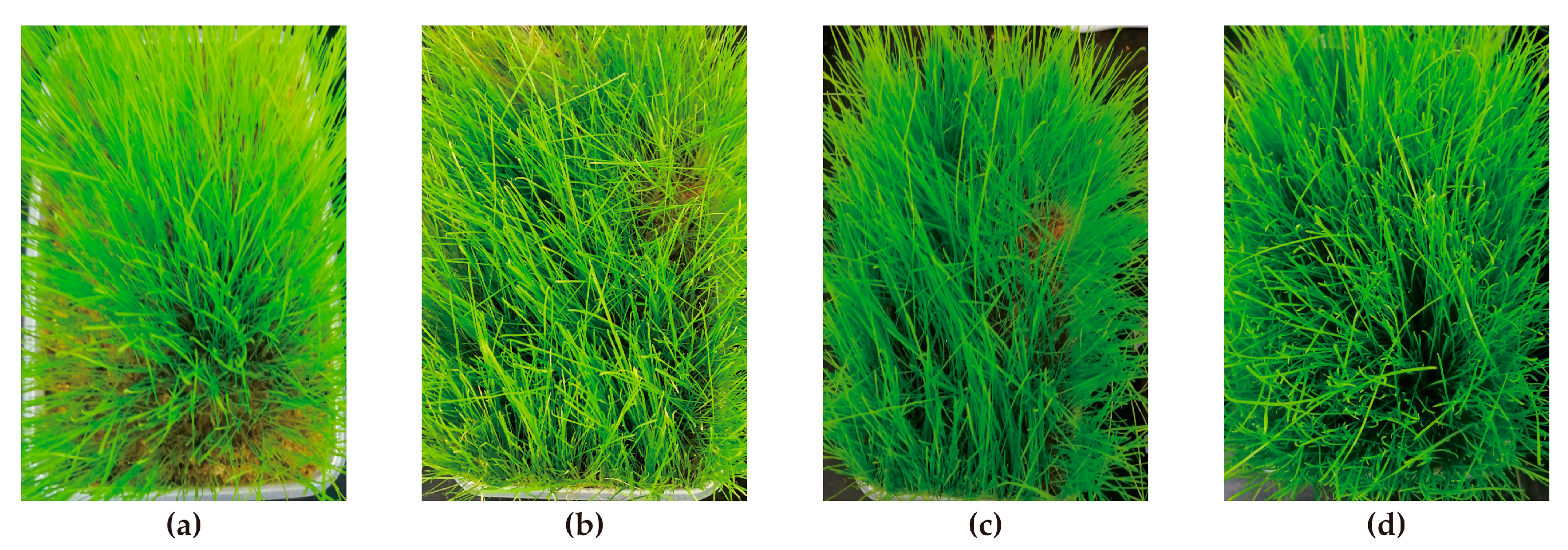
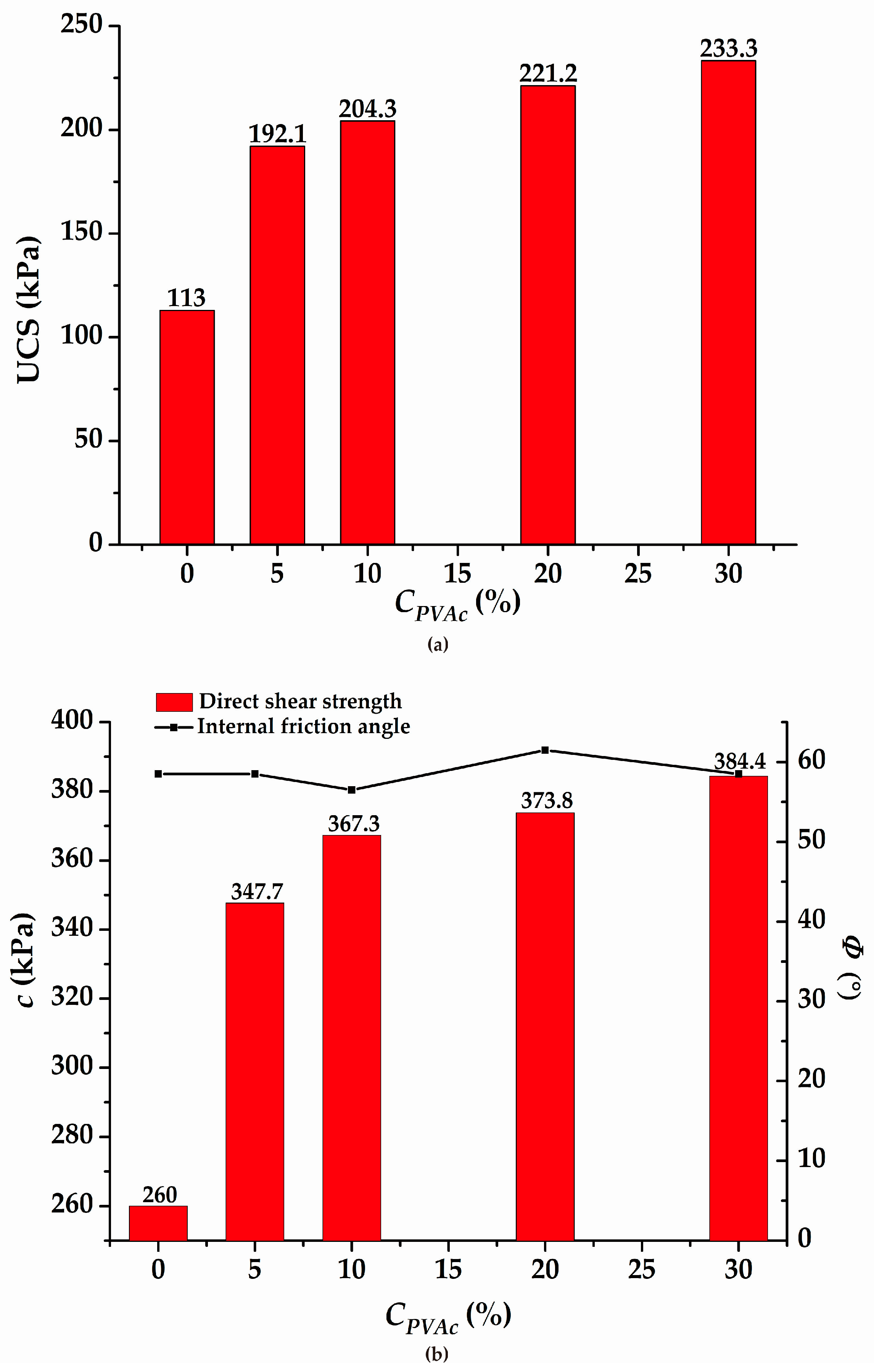
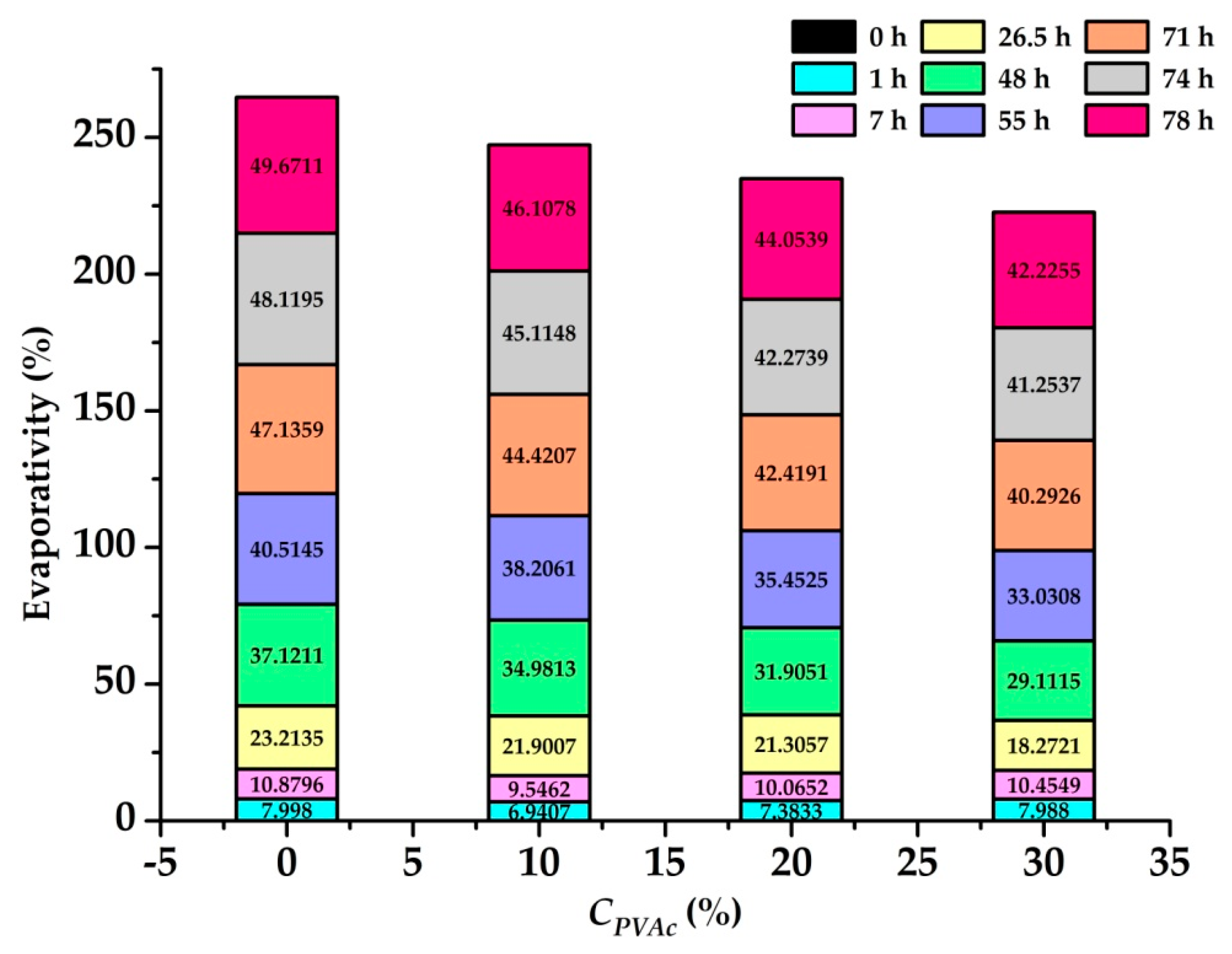



| Basic Properties | Liquid limit (%) | Plastic index Ip | Specific gravity | Optimum water content (%) | Maximum dry density ρd (g/cm3) | Free swelling ratio δef (%) |
| Values | 52.6 | 19.7 | 2.73 | 15.4 | 1.73 | 53 |
| Conditions | Tr1 (°C) | CAPS2 (%) | CVA3 (%) | pH Value | Ddi4 (%) |
|---|---|---|---|---|---|
| 40–90 | 0.05–3 | 2.5–15 | 1.93–11.87 | 0–420 | |
| Viscosity (MPa·s) | 8.8–7260 | 5–6378 | 39.23–+∞ | 217–1172 | 12.74–7020 |
| Viscosity (MPa·s) | CVA2 (%) | CAPS3 (%) | pH Value | Water Absorption (%) | Gel Fraction (%) |
|---|---|---|---|---|---|
| 716.1–904.8 1 | 10 | 0.15 | 6–7.5 | 34 | 1.48 |
| The Concentration of Polyvinyl Acetate (%) | Germination Time (d) | The Situations of Germination 1 | The Situations of Soil Structure 2 |
|---|---|---|---|
| 0 | 4 | 1 | 1 |
| 10 | 4 | 1 | 2 |
| 20 | 4 | 2 | 3 |
| 30 | 3 | 3 | 3 |
| Number | Mc1 (%) | Dd2 (g/cm3) | CPVAc3 (%) | Viscosity (MPa·s) | UCS 4 (kPa) | c5 (kPa) | Φ6 (°) |
|---|---|---|---|---|---|---|---|
| S1 | 17.8 | 1.7 | 0 | 0.0 | 113.0 | 260.0 | 58.5 |
| S2 | 17.8 | 1.7 | 5 | 168.6 | 192.1 | 347.7 | 58.5 |
| S3 | 17.8 | 1.7 | 10 | 524.5 | 204.3 | 367.3 | 56.5 |
| S4 | 17.8 | 1.7 | 20 | 2197 | 221.2 | 373.8 | 61.5 |
| S5 | 17.8 | 1.7 | 30 | 3003.0 | 233.3 | 384.4 | 58.5 |
| Situation | Application Method | Concentration Range | Cost Range (dollars/m2) |
|---|---|---|---|
| Gentle slope (slope < 35°) | Spraying 1 | 20–25% | 30–37.5 |
| Medium slope (slope: 35–65°) | External-soil spray seeding 2 | 20–25% | 40–47.5 |
| Steep slope (slope > 65°) | External-soil spray seeding + Steel net 3 | 25–35% | 46–53.5 |
| Subgrade | Mixing + Compaction 4 | 15–20% | 30–37.5 |
| River bank | Spraying | 20–25% | 30–37.5 |
| Mine restoration | External-soil spray seeding + Steel net | 25–35% | 46–53.5 |
© 2019 by the authors. Licensee MDPI, Basel, Switzerland. This article is an open access article distributed under the terms and conditions of the Creative Commons Attribution (CC BY) license (http://creativecommons.org/licenses/by/4.0/).
Share and Cite
Bu, F.; Liu, J.; Bai, Y.; Prasanna Kanungo, D.; Song, Z.; Kong, F.; Pan, C. Effects of the Preparation Conditions and Reinforcement Mechanism of Polyvinyl Acetate Soil Stabilizer. Polymers 2019, 11, 506. https://doi.org/10.3390/polym11030506
Bu F, Liu J, Bai Y, Prasanna Kanungo D, Song Z, Kong F, Pan C. Effects of the Preparation Conditions and Reinforcement Mechanism of Polyvinyl Acetate Soil Stabilizer. Polymers. 2019; 11(3):506. https://doi.org/10.3390/polym11030506
Chicago/Turabian StyleBu, Fan, Jin Liu, Yuxia Bai, Debi Prasanna Kanungo, Zezhuo Song, Fanxuan Kong, and Cheng Pan. 2019. "Effects of the Preparation Conditions and Reinforcement Mechanism of Polyvinyl Acetate Soil Stabilizer" Polymers 11, no. 3: 506. https://doi.org/10.3390/polym11030506
APA StyleBu, F., Liu, J., Bai, Y., Prasanna Kanungo, D., Song, Z., Kong, F., & Pan, C. (2019). Effects of the Preparation Conditions and Reinforcement Mechanism of Polyvinyl Acetate Soil Stabilizer. Polymers, 11(3), 506. https://doi.org/10.3390/polym11030506






